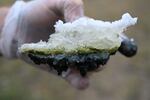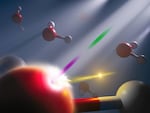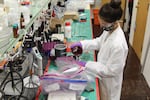
Sebastian Haas holds a piece of the salt crust from Last Chance Lake with green algae in the middle and black sediment at the bottom.
Courtesy of David Catling/University of Washington
The origins of life on Earth

Members of the research team walk across the surface of Last Chance Lake in September 2022. At the end of the summer, the water has almost all evaporated, leaving a salty crust on the surface. But water persists below in pockets and hollows, and soft sediments sit beneath, creating a somewhat treacherous crème brûlée structure to walk on.
Courtesy of Zack Cohen/University of Washington
How did life arise on Earth? Scientists believe that the building blocks — water and carbon — probably came from comets and asteroids hitting our young planet. But then after that, you need the perfect combination of conditions and resources to turn inorganic elements into organic compounds. Exactly where those conditions could have been found on Earth has been difficult to pin down.
But researchers at the University of Washington think they have found a spot in the Pacific Northwest that meets the criteria. It’s a shallow soda lake called Last Chance Lake, a few hundred miles north of Seattle in British Columbia.
Finding locations on Earth that have the right conditions to spontaneously create organic compounds is tough, in part because you need high concentrations of phosphorus. The shallow and often nearly dry Last Chance Lake fits the bill.
Based on their field and laboratory research, the scientists say soda lakes were plausible settings for the first sparks of life on Earth — and potentially on other planets as well.
The paper was published in the journal Nature Communications Earth & Environment and can be read here.

Ermias Asfaw, RN left, gives Loren Campos, 16, an immunization at a vaccination clinic held at McDaniel High School in Northeast Portland, Feb. 8, 2023. The catch-up vaccination clinic, offered in conjunction with Portland Public Schools and Multnomah County’s Education Service District, aimed to provide childhood vaccines for youth 5-19, before the immunization deadline in the schools.
Kristyna Wentz-Graff / OPB
Same vaccine, different arms
So you’re at the clinic getting a COVID vaccine, and they ask you, “What arm do you want it in?”
Which arm do you choose?
Well, if you choose the opposite arm from the one you got the first shot in, you could be making that vaccine up to four times more effective.
This is what researchers at Oregon Health and Science University discovered after monitoring the immune response of nearly 1000 people — some of whom got their original COVID vaccine and booster in the same arm and some who switched it up. The differences in immune response between the vaccines that went into the same and different arms started to appear three weeks after the second shot and increased anywhere from 1.3 to 4 times.
The scientists aren’t certain what causes the improved response, but they speculate the change in arm activates immune response in different lymph nodes, increasing the effectiveness of the vaccine.
They believe the improved protections aren’t just for COVID, but potentially any disease that has a multi-dose vaccine.
This research was published as a preview (awaiting formal publication) here in The Journal of Clinical Investigation.

Scientists used a synchronized attosecond X-ray pulse pair (pictured pink and green here) from an X-ray free electron laser to study the energetic response of electrons (gold) in liquid water on attosecond time scale, while the hydrogen (white) and oxygen (red) atoms are ‘frozen’ in time.
Courtesy of Nathan Johnson/PNNL
Attosecond-fast imagery of water atoms
Electrons move fast — so fast we don’t actually know where they are at any given moment as they orbit their atoms. If we could see them with our eyes, it would just look like a blur of motion.
So how would you get a clear image of an electron?
In photography, the way to capture a focused image of a fast-moving object is to have fast shutter speed.
And now physicists have their own version of this. In fact, last year, the Nobel Prize for Physics was given to a group of scientists who made huge strides developing a way to “see” these subatomic particles more clearly.
They developed a technique to take a snapshot in time — one attosecond long, or 0.000000000000000001 second. To get an idea of how mind-blowingly short that is: There are more attoseconds in one second than there have been seconds since the universe began.
Now researchers at the Pacific Northwest National Laboratory, University of Washington and other labs have created a new method of taking these snapshots. They applied attosecond-long x-ray pulses to water and successfully observed how the electrons in the molecules behaved.
The work could open up a whole new world in experimental physics. The researchers say the new technique will ultimately help us understand in far more detail how radiation interacts chemically with human cells in situations like space travel and cancer treatment.
Read the work in the journal Science here.
Protecting wine grapes from wildfire smoke

Jenna Fryer, an Oregon State University graduate student, processes grape samples before analyzing the grapes for smoke compounds.
Courtesy of Sean Nealon/OSU
The difference between an amazing wine and something more “meh” often comes down to the growing conditions of the grapes. With the increase in wildfires over the past decades in the Pacific Northwest, there’s growing concern that wildfire smoke in the air can imbue some undesired flavors into ripening grapes. This “smoke taint” isn’t good news for the region’s large wine industry.
Researchers at Oregon State University believe they have found a way to keep wine grapes shielded from wildfire smoke. They’ve developed a spray coating that blocks or captures several chemical compounds known to cause smoke taint. They tested the spray on open-air vines, as well as vines exposed to smoke in a specialized chamber — MacGyvered together using duct tape, a grill, aluminum duct and some plastic sheeting.
The scientists hope to have the spray fully tested and ready for wide use within a few growing seasons.
The results were published in the Journal of Agricultural and Food Chemistry here.

A graphic from Washington State University illustrates how permeable pavement filters out tire particles that become toxic to salmon in the environment.
Courtesy of Washington State University
Filtering salmon-killing tire debris
In 2020, scientists at the University of Washington and Washington State University figured out that a chemical found in vehicle tires was causing the deaths of returning adult coho salmon in urban streams. The chemical, a tire preservative called 6PPD, reacts with sunlight or ozone and transforms into the deadly 6PPD-quinone, which is then washed in the bits of tire debris into waterways during storms.
Now researchers at WSU are trying to figure out how to prevent this from happening. They tested different configurations of permeable pavement — artificial surfaces that allow water to filter through into the ground instead of running off. They’re being developed as an environmentally friendly way to manage stormwater.
After a series of experiments, they found the pavements filtered out and captured almost all of the tire particles applied and reduced 6PPD-quinone runoff by an average of 68%.
While permeable pavement is gaining popularity, durability concerns and the cost of replacing existing infrastructure means it is not yet common for roads. But these results suggest permeable roadways could help protect native salmon in high-traffic areas.
The paper in Science of the Total Environment can be read here.
In this monthly rundown from OPB, “All Science. No Fiction.” creator Jes Burns features the most interesting, wondrous and hopeful science coming out of the Pacific Northwest.
And remember: Science builds on the science that came before. No one study tells the whole story.
